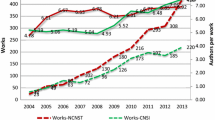Abstract
In this study we present an analysis of the research trends in Pakistan in the field of nanoscience and nanotechnology. Starting with just seven publications in the year 2000, this number has steadily increased to 542 for the year 2011. Among the top 15 institutions with publications in nanotechnology 13 are universities and only two are R&D organizations. Almost 35 % of the research publications are in the field of material sciences followed by chemistry and physics in that order. The growth in the publications for period 2000–2011 is studied through relative growth rate and doubling time. The authorship pattern is measured by different collaboration parameters, like collaborative index, degree of collaboration, collaboration coefficient and modified collaboration coefficient. Finally the quality of papers is assessed by means of the h-index, g-index, hg-index and p-index.
Similar content being viewed by others
References
Ajiferuke, I., Burell, Q., et al. (1988). Collaborative coefficient: A single measure of the degree of collaboration in research. Scientometrics, 14(5), 421–433.
Alonso, S., Cabrerizo, F. J., et al. (2010). hg-index: A new index to characterize the scientific output of researchers based on the h-and g-indices. Scientometrics, 82(2), 391–400.
Bajwa, R. S., & Yaldram, K. (2012). Research output in nanoscience and nanotechnology: Pakistan scenario. Journal of Nanoparticle Research, 14(2), 1–6.
Braun, T., Schubert, A., & Zsindely, S. (1997). Nanoscience and nanotechnology on the balance. Scientometrics, 38(2), 321–325.
Egghe, L. (2006). Theory and practise of the g-index. Scientometrics, 69(1), 131–152.
Feynman, R. P. (1960). There’s plenty of room at the bottom. Engineering and Science, 23(5), 22–36.
Gupta, V. K. (2009). Indian publications output in nanotechnology during 1990–2008. Advanced Science Letters, 2(3), 402–404.
Hirsch, J. E. (2005). An index to quantify an individual’s scientific research output. Proceedings of the National Academy of Sciences of the United States of America, 102(46), 16569.
Kaiser, H. (2009). http://www.hkc22.com/nanobasedproducts.html.
Karpagam, R., Gopalakrishnan, S., Natarajan, M., & Ramesh Babu, B. (2011) Mapping of nanoscience and nanotechnology research in India: a scientometric analysis, 1990–2009. Scientometrics, 89, 501–522.
Lawani, S. M. (1980). Quality, collaboration and citations in cancer research: A 268 bibliometric study. Ph.D. dissertation, Florida State University.
Liu, X., Zhang, P., et al. (2009). Trends for nanotechnology development in China, Russia, and India. Journal of Nanoparticle Research, 11(8), 1845–1866.
Mahapatra, M. (1985). On the validity of the theory of exponential growth of scientific literature. Proceedings of the 15 th IASLIC conference, Bangalore (pp. 61–70). Bangalore.
PINSAT (2010). http://www.pinsat-idrc.org/conceptual%20framework.html.
Prathap, G. (2010). The 100 most prolific economists using the p-index. Scientometrics, 84(1), 167–172.
Research, L. (2010). http://www.luxresearchinc.com/blog/2010/02/the-recessions-impact-on-nanotechnology/.
Roco, M. C. (2011). The long view of nanotechnology development: The national nanotechnology initiative at 10 years. Journal of Nanoparticle Research, 13, 427–445.
Savanur, K., & Srikanth, R. (2010). Modified collaborative coefficient: A new measure for quantifying the degree of research collaboration. Scientometrics, 84(2), 365–371.
Shahid, M. (2010, Dec, 6–9). S&T indicators of Pakistan a country report 2010 south Asian regional workshop on STI indicators Kathmandu, Nepal.
Subramanyam, K. (1983). Bibliometric studies of research collaboration: A review. Journal of information Science, 6(1), 33–38.
Tang, L., & Shapira, P. (2010). Regional development and interregional collaboration in the growth of nanotechnology research in China. Scientometrics, 86(2), 299–315.
Author information
Authors and Affiliations
Corresponding author
Rights and permissions
About this article
Cite this article
Bajwa, R.S., Yaldram, K. & Rafique, S. A scientometric assessment of research output in nanoscience and nanotechnology: Pakistan perspective. Scientometrics 94, 333–342 (2013). https://doi.org/10.1007/s11192-012-0699-4
Received:
Published:
Issue Date:
DOI: https://doi.org/10.1007/s11192-012-0699-4




